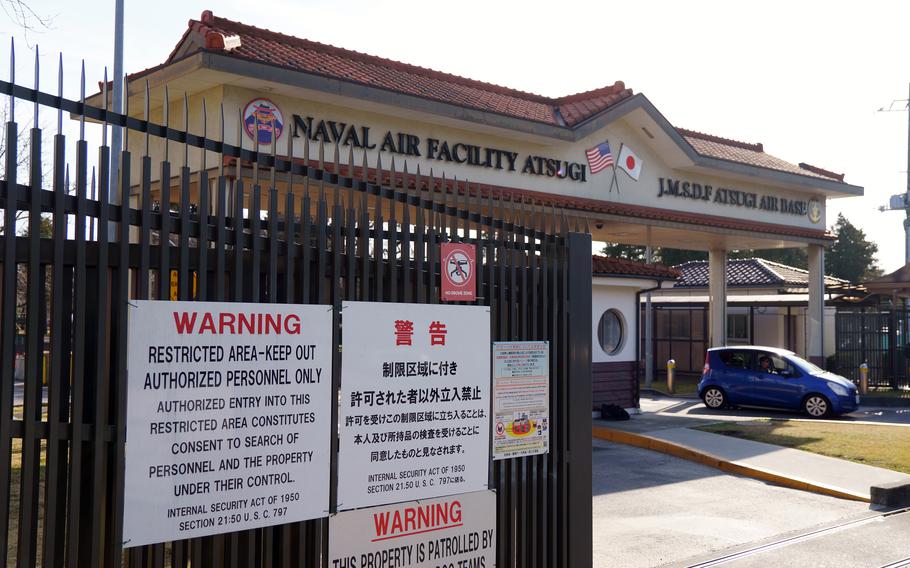
A fire-suppression system at Naval Air Facility Atsugi, Japan, accidentally released about 1,850 gallons of toxic foam, Sept. 22, 2022, according to Kanagawa prefecture. (Akifumi Ishikawa/Stars and Strip)
YOKOSUKA NAVAL BASE, Japan – Newly installed water filters appear to have reduced toxic PFAS compounds in wastewater at two U.S. bases in Japan, according to Navy and Japanese authorities.
Samples taken over the past year at Yokosuka and Naval Air Facility Atsugi, both southwest of Tokyo, revealed high levels of PFOS and PFOA, two common PFAS compounds that are suspected of causing significant health issues. The samples showed the toxins present in some cases at 258 times Japan’s provisional limit of 50 parts per trillion.
However, survey results released Monday by Kanagawa prefecture indicate that granular activated carbon filters installed by the Navy have reduced the contamination to less than 1/10th of Japan’s limit, according to a news release from the prefecture.
PFAS — per- and polyfluoroalkyl substances — are manufactured chemicals commonly found in fire-extinguishing foam widely used at airports, factories and military bases, and in household products such as electronics, paint and water-repellent clothing.
The Environmental Protection Agency refers to PFAS as “forever chemicals” because they “break down very slowly and can build up in people, animals and the environment over time.” Current research shows high levels of exposure can lead to fertility issues, developmental effects, increased risks of cancers and other health concerns.
On Sept. 22, a fire-suppression system inside a NAF Atsugi hangar accidentally released about 1,850 gallons of fire-extinguishing foam that reached a retention pond on the base, according to the prefecture. October water samples showed combined PFOS and PFOA present at 530 to 910 parts per trillion, the release states.
The combined concentration dropped to as low as 4.6 parts per trillion after the base installed the filters, according to the release.
Water damage caused the foam release, which was mostly contained inside the hangar, Naval Forces Japan spokeswoman Cmdr. Katie Cerezo told Stars and Stripes by email Wednesday.
Only a “small amount” of the foam reached the base’s stormwater system and the retention pond, she said, and the water was “successfully treated” with the filters.
Last year, several wastewater tests at Yokosuka, about 25 miles southeast of NAF Atsugi, also showed high levels of PFOS and PFOA at a wastewater treatment plant, with the highest levels around 12,900 parts per trillion.
The base installed the carbon water filters in November and removed the fire-extinguishing foam containing PFAS. By December, water sampling by U.S. Forces Japan and the Japanese government showed levels between 1.8 and 3.2 parts per trillion, according to the prefecture.
Further surveys on March 20 showed levels of 2.9 to 3.8 parts per trillion, the release said.
Cerezo declined to say whether the source of Yokosuka’s contamination has been identified but said no more high PFAS concentrations have been reported, making a “one-time, inadvertent input into the system” the “likely source.”
Recent tests showed no detectable PFAS levels at Yokosuka, she said, and Naval Forces Japan remains “committed to environmental stewardship at all of our installations.”
U.S. Forces Japan does not intend to provide further test results unless the levels exceed Japan’s 50 parts-per-trillion provisional limit, according to Kanagawa prefecture.
Cerezo said Japan Environmental Governing Standards establishes a 50 parts per trillion limit on drinking water but has no established limit for wastewater.
“The latest testing shows no detectable level of PFOS in the wastewater treatment plant,” she wrote in her email. “Since it is at the non-detect level, the need to continue to report is no longer warranted.”